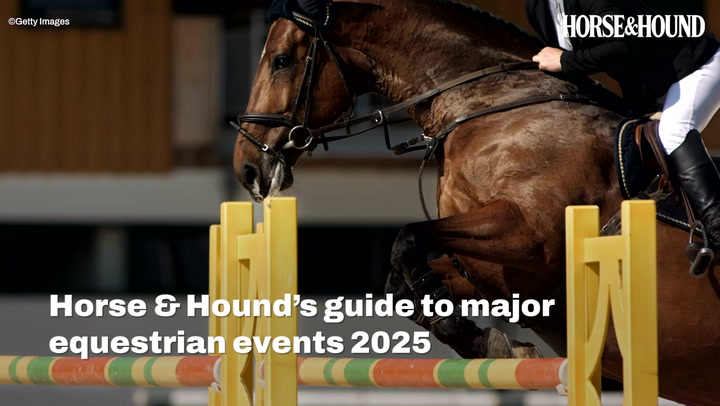I passed the landmark age of 75 in September and am ramping down my cross-country course-designing. I leave this week for the US for what will probably be my last CCI4*-L course, at Terra Nova in Florida.
In contrast, my course advisor consultancy is on the increase and I enjoyed helping with the junior and young rider European courses in Montelibretti this summer. I see my role now as trying to help the next generation of course-designers. Alec Lochore takes over at Terra Nova next year and Helen West at Stable View, South Carolina, and I’ll continue to help at both venues.
 Watch the video
Watch the videoI was super-happy for Ian Stark, who got his five-star track up to speed in spectacular fashion in his third year at Maryland 5 Star. That’s no surprise – it takes three years to get to grips with a venue and the level at five-star. Ian is a super talent and when he retires at the end of next year, he will leave a void that the sport will struggle to fill.
Everyone was happy for Austin O’Connor when he won in Maryland. He decided not to go to the Europeans, but came to the Festival at Gatcombe, which was rained off, and then Burghley, where he had an early glance-off. It’s nice when persistence finally pays off!
Returning to course-design, I was also pleased to see Adrian Ditcham’s improvements at Boekelo. Also in his third year, he has brought more size to this course since the Sue Benson era and with a change in the site meaning fewer woods, no maize fields and more grass, he provided some interesting questions.
I understand why the FEI wants organisers to change designers at four-star every six years and at five-star every eight years, to give more designers a chance to develop. However, as we keep seeing, it takes time for a new designer to build up to the standard. We are in danger of seeing too many designers in the build-up phase, which means more disparity at every level than currently, giving riders increased opportunities to get cheap qualifications – so much for risk management!
How the sport has changed
Looking back over 50 years, it’s amazing how things have changed. I was fourth at Burghley at 18 and fourth at Badminton at 19, before realising I had to learn to trot in a 20-metre circle. Richard Meade, Richard Walker, Jane Holderness-Roddam, Princess Anne, myself and others all enjoyed five-star wins or international success in our early twenties.
It’s a sad reflection on the modern sport that the young rider (21 and under) European Championship is now at CCI3*-L, whereas it used to be CCI4*-L.
I know my generation grew up with the “long format” and the technical requirements in all the phases have increased. Combining that with the qualification boxes that must be ticked, it’s not surprising it takes so long for today’s young to gain the skills and experience needed for consistent top-level success.
Of course, a superstar horse can accelerate the process. I’m embarrassed to say I didn’t realise how good Ros Canter was until she hit the headlines with Allstar B around 2017. She is now 37 and the outstanding professional rider of our time.
At the other end of the scale, I retired after the Seoul Olympic Games, where I had my 40th birthday, feeling I was struggling to stay competitive. Back then, Bill Roycroft, Derek Allhusen and Eddie Boylan had competed in their later years, but now you have Andrew Hoy, Phillip Dutton and company in their sixties. Maryland runner-up William Fox-Pitt is one of a multitude of riders still going in their fifties.
More broadly, thank goodness the future of the three Olympic disciplines is guaranteed in Los Angeles in 2028 and I can’t see the Aussies wanting to lose equestrian sports in Brisbane in 2032, but after that my crystal ball is a little cloudy.
Meanwhile, we have to continue to work overtime to show the public how much we love and respect our four-legged partners.
● Why do you think it’s harder for young riders to do well at the top level these days? Write to us at hhletters@futurenet.com, including your name, nearest town and county, for the chance to have your views published in a future edition of Horse & Hound magazine
- This exclusive column is also available to read in Horse & Hound magazine, on sale Thursday 2 November, 2023
You may also be interested in…

‘The result of a lifetime’s work’: an emotional Maryland 5 Star win amid leaderboard shake up

‘One of the best in the world’: British rider wins phenomenal second five-star of 2023

‘Various people have tried to talk me out of it’: Ian Stark plans his ‘semi-retirement’

‘Dressage is too influential in eventing today – bring back the steeplechase’: H&H’s exclusive catch-up with Lucinda Green

Subscribe to Horse & Hound magazine today – and enjoy unlimited website access all year round
Horse & Hound magazine, out every Thursday, is packed with all the latest news and reports, as well as interviews, specials, nostalgia, vet and training advice. Find how you can enjoy the magazine delivered to your door every week, plus options to upgrade your subscription to access our online service that brings you breaking news and reports as well as other benefits.




